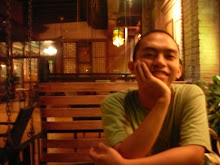
It's funny to look back at times when people asked me of one of the toughest, million-dollar questions I have ever had in my life: "What is your religion?" It really seemed a big deal, since the time when I started exploring other religions, it was hard to label myself of a religion where I really belong. The question is a very sensitive matter, almost a taboo. Talking to people who have their convictions on their own religious denominations could start from a hearty talk to rough disagreements. Many religions have different ways of experiencing and expressing their respect to God, through a myriad of rituals and doctrines. Both are the most common arenas where zealous followers will contend their beliefs and urge new converts. I couldn't help but to stay silent and listen to their powerful convictions, let alone the pretense that I understand.
I once dreamed to become a religious anthropologist just to learn more about why religions are different and in what way they are the same. But through the help of a university professor who lectured on eastern religions, I was able to see the two most important ways in learning a religion, without needing to spend tuition fees and tormenting studies. First, religions have an external layer, where all of the details and accessories can be found. In the external layer, history is different, language is different, rites are different, beliefs are different. This is where many Christian denominations clash, as well as the sects within other major religions. This is the common battlefield where historical wars "in the name of God" took place. This is where a follower believes that his way is the "only way" and other ways are led astray. This is where most organized religions will strongly fight over the "truth" and build walls to protect their followers from the heathens and nonbelievers.
The external layer is the main reason why the term ecumenism and interfaith/interreligious dialogue are coined. "Peace talks" among religions are made. Religious authorities meet halfway, trying to harmonize all labels and bridging all the gaps to mitigate misunderstandings. They initiate efforts to establish consonance of perspectives about life, humanity, spirituality, and God. These are all important undertakings in the time when peoples of the world can connect and communicate, and exist together in many dimensions of life.
Nonetheless, it is time to seek for the second way, the internal layer. The internal layer is not a dialogue of premises nor contentions of concepts. It is the understanding that all humans, whatever religious practice, have the same experiences and aspirations. The internal layer develops the perspective of universality, beyond the language of doctrines and symbols of rituals. It seeks not to meet halfway, but to be whole in many ways. We all experience suffering, misery, pain and fear. We all aspire for peace, abundance, joy,
 harmony, and Love. Through understanding the internal layer, we can share with another human being our humanness, without the need to identify ourselves with any religion. We are now seeking the root. Despite our differences, we are all One. We are more than the labels of our religious tradition, because the Love within us cannot be labeled by any means.
harmony, and Love. Through understanding the internal layer, we can share with another human being our humanness, without the need to identify ourselves with any religion. We are now seeking the root. Despite our differences, we are all One. We are more than the labels of our religious tradition, because the Love within us cannot be labeled by any means.It is not that I can be a Catholic, a Buddhist, a Muslim, a Hindu, a Taoist, a Jew, a Jain, a Shinto all at the same time. I can only be human, seeking for the true meaning of life. This is the same for the whole humanity. What I can do is to Love, because I am Love. The awareness of Love transcends all languages of differences. We are not anymore seeking to convert people nor to be converted from one religion to the other. The internal layer sees this unnecessary. Meditation teacher S.N. Goenka addressed these words at the United Nations Peace Summit: "We should try to convert people fom misery to happiness, from bondage to liberation, from cruelty to compassion." The best we can do is not to push in and pull out people from any beliefs. Rather, we begin converting people from the experience of fear to the experience of Love.
In his message after the 9/11 attacks, the Dalai Lama said a very powerful wisdom on religion. "My religion is very simple. My religion is kindness." His words struck me a new insight. Now, the question that puzzled me is no longer tough to answer. Inspired by the Dalai Lama, I always reply, "My religion is Loving-kindness." Our ability to understand and share the wisdom of Love is our true religion. This is the only truth that can set us all free.










0 comments:
Post a Comment